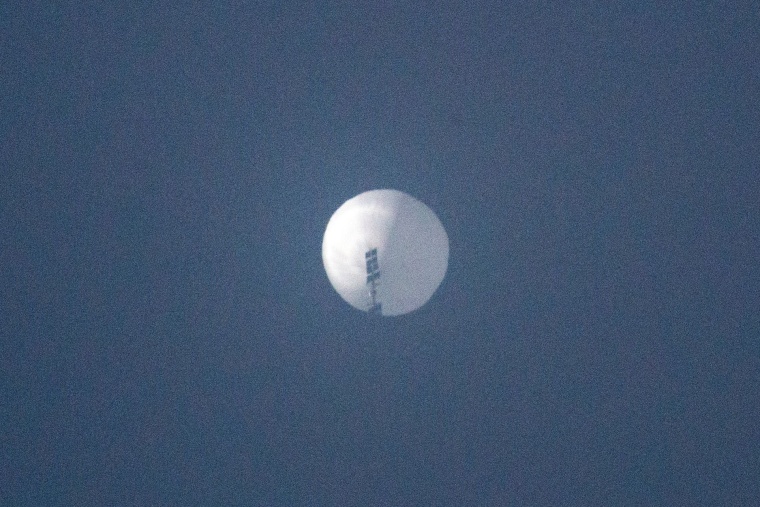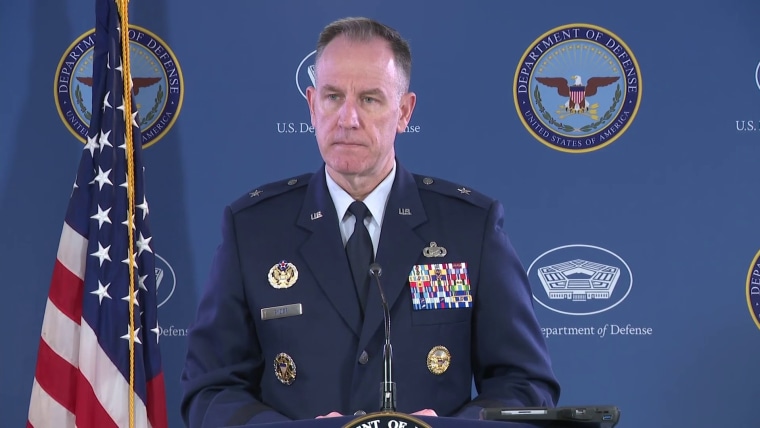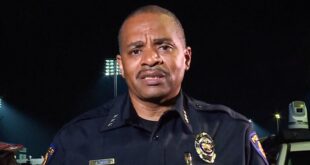
The Pentagon said Friday it does not plan to shoot down a suspected Chinese spy balloon floating 60,000 feet above the U.S. because “any potential debris field would be significant” and could cause “civilian injuries or deaths or significant property damage” — but did not provide a plan to respond to the slow-moving violation of “U.S. airspace and international law.”
The huge balloon has ignited domestic curiosities, political finger-pointing, and an international diplomatic crisis, leaving Americans across the middle swath of the country looking to the skies for the white floating apparatus.
Where it will go — and whether the U.S. military may ultimately opt to shoot it from the sky — remains unknown, but officials have confirmed it continues to move east across the continental United States and are dismissing Beijing’s insistence it is a weather balloon that got blown off track.
The U.S., however, is already taking action to weaken its surveillance capabilities, including using counter intelligence measures to obscure its views and physically moving things out of its path, two senior defense officials told NBC News on Friday.
“We will continue to monitor and review options,” Pentagon spokesperson Brig. Gen. Pat Ryder told reporters early Friday afternoon.
“The balloon continues to move eastward and is currently over the center of the continental United States,” Ryder said, adding that “we currently assess the balloon does not present a military or physical threat to people on the ground at this time.”
Asked if he was concerned some Americans might try to “interfere” with the balloon — presumably, by intercepting it or trying to shoot it down — Ryder noted the balloon is flying at a height of approximately 60,000 feet, which is about 11 miles above the ground. It’s “well above the range of civilian air traffic,” Ryder said.
The Federal Aviation Administration said in a statement it was working with the Pentagon “to support any needed US government response.”
“The balloon does not currently pose a hazard to civil aviation. If that changes, the FAA is prepared to take action,” the agency said.
The Chinese government acknowledged the craft “is from China.”
“It is a civilian airship used for research, mainly meteorological, purposes,” the Chinese Foreign Ministry said in a statement on its website. It said the balloon “deviated far from its planned course” because of strong winds and a lack of steering ability.
Ryder countered, “The fact is we know it’s a surveillance balloon.”
“It has the ability to maneuver,” he said, while declining to go into specifics.
The U.S. military had been monitoring the balloon for days, U.S. officials and a senior defense official told NBC News on Thursday.
The Pentagon assessed the balloon to be roughly the size of at least two school buses, a U.S. official said.
It was spotted over Billings, Montana, on Wednesday, and had flown over Alaska’s Aleutian Islands, and through Canada to get there, officials said. The destination is notable because Montana is home to one of America’s three nuclear missile silo fields.
Ryder declined to give the balloon’s exact location Friday.

Sen. Roger Marshall, R-Kan., said Friday afternoon the balloon was above his state. “I can confirm the Chinese spy ballon is over NE KS. My staff is in contact with law enforcement officials,” he tweeted, adding “I condemn any attempts the Chinese make to spy on Americans.”
The discovery has heightened tensions between the U.S. and China, with Secretary of State Antony Blinken postponing a planned trip to Beijing.
“We have concluded that the conditions are not right at this moment for Secretary Blinken to travel to China,” a senior State Department official said.
Blinken confirmed the postponement during a press briefing Friday, but said “we are going to remain engaged with the PRC [People’s Republic of China] as this ongoing issue is resolved. The first step is getting the surveillance asset out of our space. And that’s what we’re focused on.”
Ryder told reporters Friday that the balloon’s presence “violated U.S. airspace and international law, which is unacceptable. We have conveyed this directly to the PRC at multiple levels.”
Secretary of Defense Lloyd Austin convened a meeting of senior military and defense leaders on Wednesday, including Chairman of the Joint Chiefs of Staff Gen. Mark Milley and NORTHCOM/NORAD Commander Gen. Glen VanHerck, to discuss military options to take down the balloon.
Pentagon leaders presented those options to President Joe Biden on Wednesday, and he was given a “strong recommendation” that the balloon not be shot down, senior administration official told NBC Thursday.
The official said the administration “acted immediately to protect against the collection of sensitive information” being sought by the balloon, and noted this wasn’t the first time this has happened.
“Instances of this activity have been observed over the past several years, including prior to this administration,” the official said.
Asked Friday about those prior instances, Ryder declined to comment on specifics, citing the classified nature of those events, but acknowledged “there have been past incidents.”
Sen. Jon Tester, a Democrat from Montana and the chair of the Defense Appropriations Subcommittee in the Senate, announced Friday that he would hold a hearing on the Biden administration’s response to the balloon that appeared over his state.
“I’m demanding answers from the Biden Administration,” Tester said in a statement. “I will be pulling people before my committee to get real answers on how this happened, and how we can prevent it from ever happening again.”
Several Republican lawmakers criticized the administration’s response as well, with Sen. Tom Cotton of Arkansas saying Biden “should stop coddling and appeasing the Chinese communists. Bring the balloon down now and exploit its tech package, which could be an intelligence bonanza.”
Staff members for the so-called Gang of Eight, a bipartisan group of leaders in Congress, were given a classified briefing Thursday afternoon on the balloon, three sources familiar told NBC on Friday.
A spokesperson for Senate Majority Leader Chuck Schumer, D-N.Y., said the lawmakers in the group would get an in-person briefing from the administration next week.
 Latest Breaking News Online News Portal
Latest Breaking News Online News Portal






